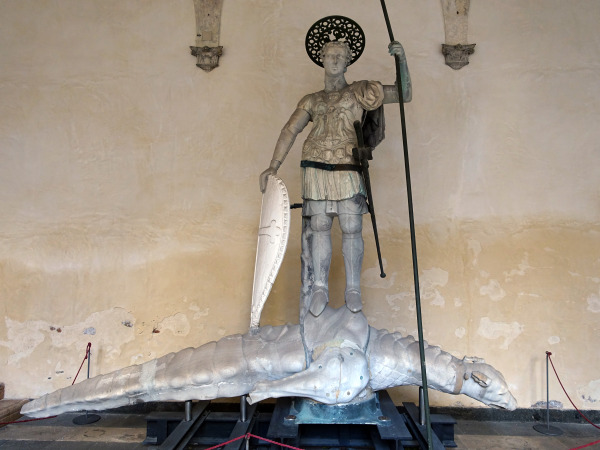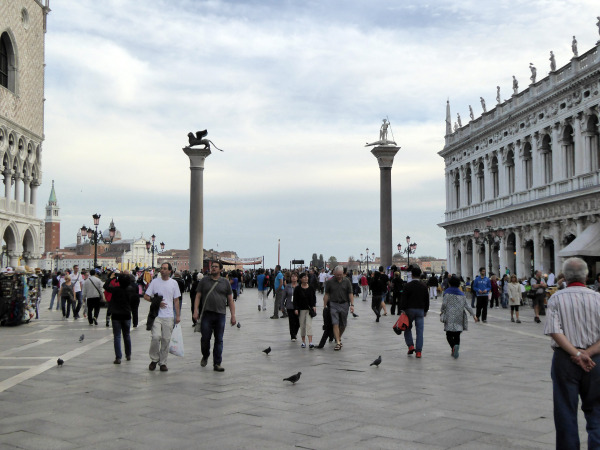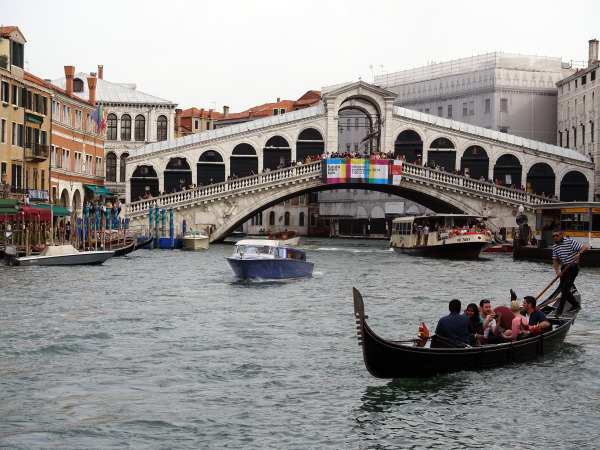
From the 11th-16th centuries, Venice was the Master of the Sea, the Merchant to World and the greatest Naval power in Europe. She was known as ‘La Serenissima’, ‘Il Stato da Mar’ and ‘La Dominante’. The Republic of Venice was so obsessed with it’s maritime livelihood that every Ascension Day, the Doge would sail to the mouth of the lagoon in his ceremonial Golden boat, the Bucintoro and reaffirm the marriage vows of Venice to the Sea.
From the simple beginnings as eel trappers, salt panners and bargemen these settlers of the lagoons eventually turned Venice into the wealthiest merchant city in the world. She controlled the world’s trade of pepper, ginger, cinnamon, cloves, silk, flax, cotton, wool, furs, olives, sugarcane, lemons, oranges, figs, almonds, dates, musk, ivory, pearls, incense, exotic wood, iron, military arms and eventually slaves.
By the 16th century it was all coming to an end. Portugal and Spain discovered new routes to India and the New World.
In the 17th century the Dutch, English and French joined the age of discovery and by the 18th century Venice was sold off to the Austro-Hungarian Empire by Napoleon, a sad end to a once great empire.
The Republic of Venice was more like a corporation than a Republic. The flag of the Lion of St. Mark was her corporate logo. She had no moral restrictions when it came to making a profit and her trade with Muslims and attacks on Christian Republics got her excommunicated several times from the Catholic Church. It mattered not. The Signoria (ruling congress) of Venice always knew the Pope would come back to them pleading for funds or ships.
Although Venice was a wealthy merchant city by the 11th century, it was the 4th Crusade and the Sack of Constantinople in 1204 that filled the coffers and made the jump from local power to world power.
Actually, the birth and death of the glory of Venice was tied to Constantinople. In 1453, the Muslim invasion of Mehmet II took the city and in the following 295 years, Venice lost almost everything to the onslaught of the Ottoman Turks.
In 1198, Pope Innocent III cut a deal with Venice to build a fleet of 500 ships and take 33,500 crusaders to the Holy Land to fight the Muslim armies of the Sultan Saladin. The agreed price was 94,000 silver marks (1 mark = 8 ounces). In today’s dollars, it’s about $14,700,000.
The Crusaders would arrive to Venice bringing the payment from their resident countries of France, the Papal States and a few smaller groups from Hungary and Swabia.
By 1201, the great Crusading army trickled into Venice in numbers much lower than expected. By the time the sailing season of 1202 arrived there were barely 12,000 assembled and barely 35,000 silver marks paid.
When Venice threatened to pull out, Innocent III came up with another 14,000 but the sum was still 45,000 marks short.
At this point, Enrico Dandolo, the 92 year old, blind Venetian Doge came up with plan B.
The secret destination of the 4th Crusade was to attack Egypt and cut the supply routes to Jerusalem but when the money never came, Dandolo figured he could use the Crusading Army to settle a long standing feud with the Dalmatian Republic of Zara (modern day Zadar). He figured the wealth he would take from Zara would pay off most of the debt owed to Venice.
Zara was wiped out, pillaged and burnt to the ground and an appalled Pope Innocent III excommunicated Venice from the Church. However, they were still allowed to continue the Crusade.
It was during the Siege of Zadar when Enrico Dandolo was introduced to Alexius IV Angelus, son of the imprisoned Emperor Isaac II Angelus of Constantinople, who was overthrown by his uncle, Alexius III. The succession of Emperors of Constantinople is filled with lots of murder, blinding and intrigue.
Alexius IV promised Enrico Dandolo payment of the debt owed by the Crusade (the 45,000 silver marks) plus another 20,000 marks plus 10,000 troops and the Byzantine Navy if the Crusaders would agree to reinstate him to the throne of Constantinople. Dandolo agreed.
In 1203, The Crusader army breached the walls of Constantinople, the first time since they were built in the 5th century by Theodosius II.
Alexius III, the usurper uncle, gathered up the royal treasure and fled the city. Alexius IV was installed as the new Emperor and all was well for a couple months until he refused to make good on his promise of payment to Enrico Dandolo.
While Dandolo and the Crusaders once again laid siege to the fortress walls of Constantinople from the outside, a royal coup took place on the inside. Alexius IV and his blind father (Emperor Isaac II Angelus) were killed and the power of the city was usurped by Alexius Doukas, known as Murtzuphlus (the shady one) because his large bushy eyebrows cast a shade over his face.
Murtzuphlus called himself Alexius V. However, his reign didn’t last very long either.
On April 13, 1204, the Venetian and French troops entered the city. Murtzuphlus gathered whatever he could and fled although he didn’t make it very far. He was brought back to Constantinople and thrown from the 98’ tall Column of Theodosius to his death.
Constantinople had never been occupied by a foreign invader, not in it’s 874 years since Constantine founded his new city of Rome in 330. The city treasure went back to the great Roman Emperors. It was the greatest treasure of the known world. The Crusader army had never seen such wealth before and they went insane with lust of wealth. Churches were destroyed and pillaged for gold, silver, icons and relics. Byzantine Priests were slaughtered, nuns were raped. Tapestries were torn from the walls.
The Great Library of Constantinople was destroyed. Jewels were pocketed by high ranking Knights, gold, silver and bronze were melted down and divided amongst the Crusaders. It took 4 oxen just to cart away the giant bronze head of Hera that ultimately ended up in a furnace and melted down into coins.
Dandolo gave the Crusaders three days to loot the city but the pillage lasted a week. It was the worst Christian on Christian attack in history.

Aside from a major share of the loot, Enrico Dandolo also brought a few mementos back to Venice as souvenirs of the great victory. The most famous of the treasures are the 4th century bronze horses that were raised over the facade of the Basilica of St Mark.
The four horses were once part of the quadriga that stood in the Hippodrome of Constantinople. They are now kept inside the Cathedral on the upper floor, protected from the elements. They are magnificent. The horses that currently decorate the façade are copies, made in the 1980’s.
 The porphyry carving of the Four Tetrarchs embedded into the façade of the Basilica of San Marco (to the side towards the Doge’s Palace as you walk towards the lagoon) was taken from the Philadelphion (Palace of Brotherly Love) in Constantinople.
The porphyry carving of the Four Tetrarchs embedded into the façade of the Basilica of San Marco (to the side towards the Doge’s Palace as you walk towards the lagoon) was taken from the Philadelphion (Palace of Brotherly Love) in Constantinople.
The Tetrarchy was created by the Emperor Diocletian in the 3rd century in his attempt to hold together the over expanded Roman Empire. The porphyry carving of the Four Tetrarchs was created around the same time.
The ancient bronze doors of the Basilica San Marco were stolen from Constantinople.
The Archangel Michael and most of the upper third of the Pala d’Oro, the High Altarpiece inside the Basilica San Marco came back with Enrico Dandolo.
A Roman statue taken in the plunder was used as the body of St Theodore (the first patron saint of Venice) on top of one of the twin columns that sit at the Molo, the entrance to the lagoon of Piazza San Marco.
 The original statue is now just off the main courtyard inside the Doge’s Palace. The current one is a copy.
The original statue is now just off the main courtyard inside the Doge’s Palace. The current one is a copy.
The crocodile by Saint Theodore represents the aqua dragon he slayed. It was explained to us that since Venice was a city of the sea, a water dragon was more appropriate for their patron Saint to defeat.
St. Theodore lasted as the Patron Saint till 828 when some Venetian merchants stole the bones of St Mark from Alexandria and hid them in a barrel of pork fat to get them out of Egypt.
The Muslim customs agents would not go near a barrel of pork anything. Mark was a much bigger fish in the sea of Saints and so Theodore was demoted.
The two towers on the Molo, the entrance to the Lagoon from the Piazza San Marco were erected in 1268.
One column supports the Lion of Saint Mark. The other is crowned with St. Theodore and his pet crocodile.
 During the 13th century, the only place where gambling was permitted was between the columns.
During the 13th century, the only place where gambling was permitted was between the columns.
Public executions were also carried out between the columns and according to some historical records more homosexuals died between the ‘Columns of Justice’ than anywhere in Europe prior to Hitler.
For about 175 years the death sentence was to be burned alive. After 1446, the Venetian justice got a little more compassionate. The offenders were decapitated first and then burned in the fire.
I strongly recommend a tour of the 14th century Doge’s Palace. The painting of the Conquest of Constantinople by Tintoretto is a great Venetian version of the attack of the 4th Crusade. This is the painting I used at the top of this entry.
There is also a portrait of Enrico Dandolo sworn in as leader of the 4th Crusade in the Sala del Maggior Consiglio (the Council Hall).
Another point of interest in the Sala del Maggior Consiglio are the portraits of the 76 Doges of Venice from the 7th to the 18th century. If you look closely you’ll notice one of them is missing. He is Marino Faliero who was executed for treason in 1355. His is replaced with a black curtain. Faliero was elected Doge after the death of Enrico Dandolo. Before his election he was a naval hero and diplomat. His crime was in the attempt to remove the power of the aristocrats but the plot was so badly planned that Faliero was the only thing to be executed. He was condemned to ‘damnatio memoriae’, his entire life wiped clean from the historical records of Venice. Ironically, as a result of the act, he has become one of the most famous of all the Doges.
 On the south wall of the Basilica near the Tetrarchy are The Pillars of Acre, two rectangular pillars named after the city of Acre (now in northern Israel) where the Venetians defeated the Genovese in 1258.
On the south wall of the Basilica near the Tetrarchy are The Pillars of Acre, two rectangular pillars named after the city of Acre (now in northern Israel) where the Venetians defeated the Genovese in 1258.
The wars between the Republics of Venice and Genoa lasted over 150 years.
In realty, the pillars of Acre were actually part of the stolen booty from Constantinople. They are currently believed to be from the now destroyed Church of St Polyeuctus.
Although Saint mark is the most revered relic of Venice, the 4th crusade brought a bonanza of bones and relics back to the city. They brought back Santa Lucia, Santa Agatha, San Simeon, San Anastasius and Saint Paul the Martyr.
So many relics came back to the Republic, over the years most of them got lost or misplaced. In 1971, the relic of the head of Saint George was rediscovered in a cupboard in the Church of San Giorgio Maggiore by the American Medieval Historian, Kenneth M. Setton.
 Near the Pillars of Acre, over on the Doge’s palace side of the Basilica is a small stump of porphyry known as the Pietra del Bando, also known as the Proclamation Stone.
Near the Pillars of Acre, over on the Doge’s palace side of the Basilica is a small stump of porphyry known as the Pietra del Bando, also known as the Proclamation Stone.
This one was taken from the Battle of Acre in 1258. When the stone came back to Venice it was first used as the place where the judgment of traitors of the Republic was read. The heads of these traitors were consequently displayed on the stone.
One final note on the 4th Crusade. Pope Innocent III excommunicated the Republic of Venice for the Christian on Christian attacks at Zara and Constantinople although the excommunication didn’t last for too long.
In 1209, five years after the Sack of Constantinople, the same Pope Innocent III launched the Albigensian Crusade against the Christian sect known as the Cathars. This was wholesale slaughter in the name of God. It was a very sad time in both Christian and human history.
Today, La Dominante is one of the tourist capitals of the world. She is a living historic museum. The Arabic influenced architecture of the 12th and 16th centuries still reign over the grand canal.
 The Rialto and the Piazza San Marco still show the glory that once was and the Basilica San Marco is without a doubt, one of the most beautiful Catholic cathedrals in the world.
The Rialto and the Piazza San Marco still show the glory that once was and the Basilica San Marco is without a doubt, one of the most beautiful Catholic cathedrals in the world.
The Rialto was the traditional commercial center of the city. The markets opened up here in 1097.
The Rialto Bridge was originally a pontoon bridge known as the Ponte della Moneta, most likely because the mint was close by.
When boat traffic increased the old bridge was replaced in 1255 with another wooden bridge with a moveable center section to allow the boat traffic. This one lasted 190 years till it collapsed from the weight of too many people crowded on the span to see a boat parade.
The stone bridge was proposed in 1505 but it wasn’t completed until 1591.
The design by Antonio da Ponte was considered inferior and dangerous by most of the architects of the time but it had lasted for over 423 years and still going.
The Gobbo di Rialto is a granite statue opposite the Church of San Giacomo di Rialto.
 It’s a 16th century hunching hunchback. It was here that the names of traitors were read at the same time they were read in Piazza San Marco from the Pietro del Bando. It was also used as the final embarrassment for misdemeanors where the guilty were stripped naked and sent from Piazza San Marco to the Rialto, encountering the blows of the citizens lining the streets and bridges. When they got the Gobbo they had to lower themselves and kiss the statue. Failure to do so would incur further abuse.
It’s a 16th century hunching hunchback. It was here that the names of traitors were read at the same time they were read in Piazza San Marco from the Pietro del Bando. It was also used as the final embarrassment for misdemeanors where the guilty were stripped naked and sent from Piazza San Marco to the Rialto, encountering the blows of the citizens lining the streets and bridges. When they got the Gobbo they had to lower themselves and kiss the statue. Failure to do so would incur further abuse.
You must be logged in to post a comment.